Product information, Solar inverter, User manual
Deye inverter installation guide
Nội dung
Deye inverter installation guide
Deye is a well-known brand in the field of inverters and related products. Installing a Deye inverter is usually simple, however, I need to know what you are installing the Deye inverter for (e.g. solar system, backup generator, etc.) to be able to provide provide more detailed instructions. Here is a general guide on installing Deye inverter for solar system: Deye inverter installation guide. Deye inverter installation guide
Important Note: Electrical installations and inverters require electrical and safety knowledge. If you are inexperienced, it is best to seek assistance from a professional contractor.
Install Deye Inverter for Solar System:
- Prepare equipment and tools:
- Inverter Deye and accessories included.
- Power cables, PVC pipes (if needed), screws, nails etc
- Basic tools like hammer, screwdriver, wrench, etc
- Measuring instruments such as pens, rulers, and multimeters.
- Select installation location:
- Choose a place that is cool, dry and has the necessary space for the inverter.
- Avoid places exposed to direct sunlight and dusty environments.
- Installing inverter: Deye inverter installation guide
- Place the inverter in the selected location, make sure there is enough space around the inverter for ventilation and maintenance.
- Attach the inverter to the wall or foundation with screws and nails.
- Cable connection:
- Following the instructions of the Deye inverter, connect the wires from the system components such as the solar panels, the inverter, and the inverter’s control panel.
- Make sure to connect the wires properly, follow the wire color code to avoid confusion.
- Check settings:
- Before turning on the inverter, check all the wiring connections again.
- Check that all parameters and settings on the inverter are suitable for your solar system. Deye inverter installation guide
- Turn on the inverter:
- Power on the inverter according to the product instructions.
- Observe the inverter and system to make sure everything is working properly and there are no error messages.
- Check operation:
- Monitor the inverter for the first few days to make sure it’s working properly.
- Monitor parameters displayed on the inverter, such as input voltage, output voltage, current, and efficiency.
- Regular maintenance:
- Perform routine maintenance according to the manufacturer’s instructions to ensure efficient operation and longevity of the inverter.
Be sure to check the instructions for the specific Deye inverter you are using, as there may be differences in installation and wiring depending on the specific model.
In addition, if you are an installer or retailer in the provinces of Vietnam, you can contact the official distributor in Vietnam: Powertech.vn for support.
Note: non-retail distributors, retail buyers, buy and use can contact us directly for the best advice.
Deye inverter installation guide
Step 1: Go to Settings and select Basic Settings
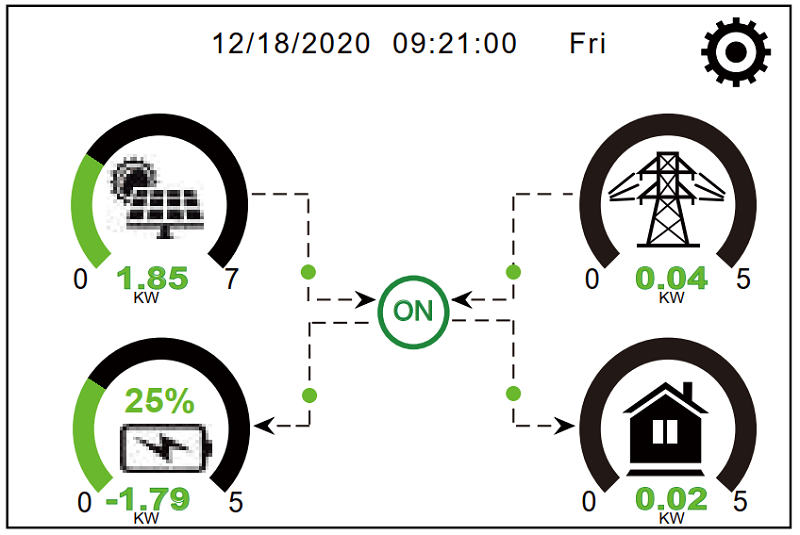
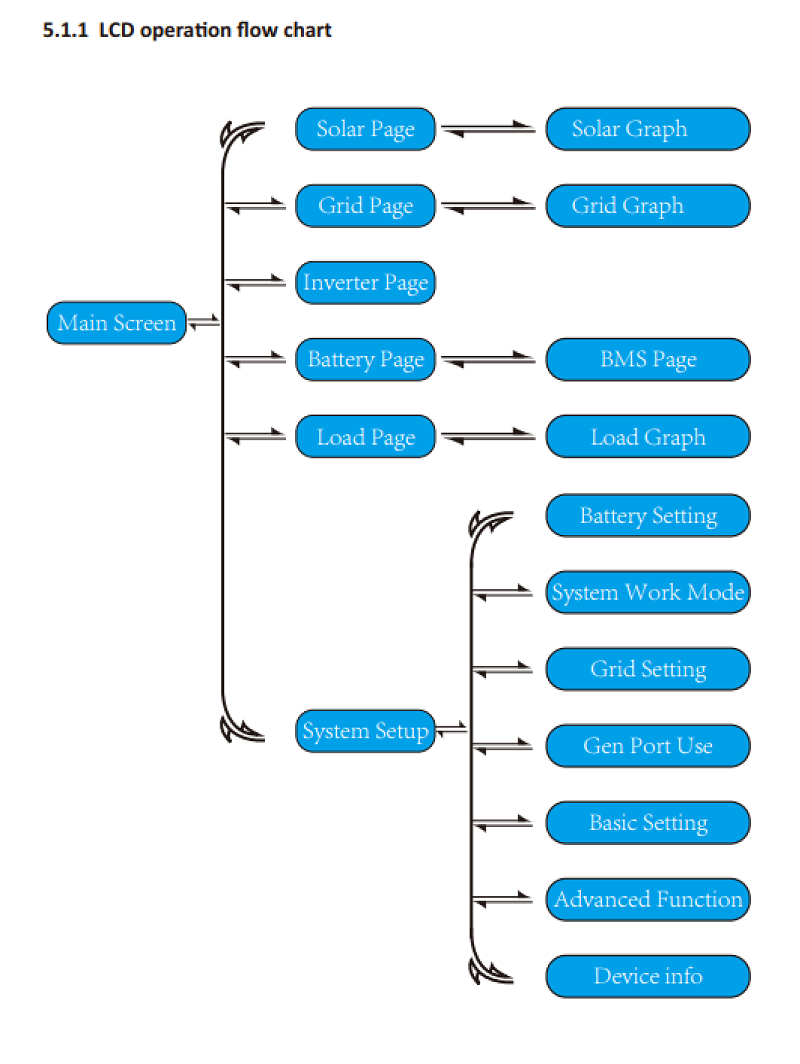

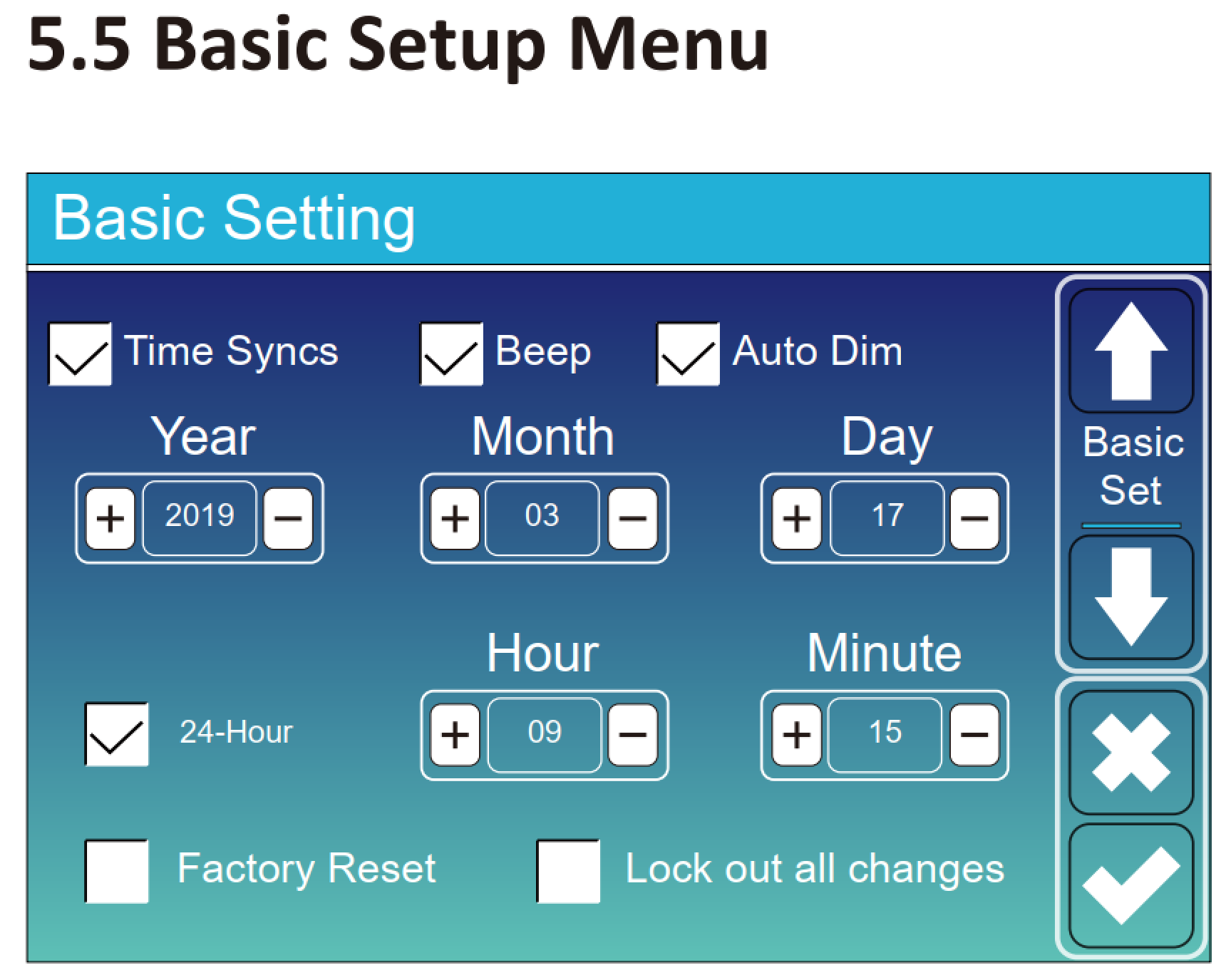
- Uncheck the Beep item Tick. Deye inverter installation guide
- Click the Tick on the save screen. Deye inverter installation guide
Step 2: Choose a password to enter edit
Factory Reset: Reset all inverter parameters to factory default values. Lock all changes: Enable this menu to set parameters that need to be locked and cannot be changed. Before performing a successful factory reset and locking the system, to keep all changes you need to enter the password to activate the setting. Password for factory setting is 9999 and for key is 7777.
Factory Reset Password: 9999 Password X–X–X–X DEL 1 2 3 4 5 6 7 8 9 CANCEL 0 OK Password Lock all changes: 7777 Automated system check: After selecting For this item, you need to enter a password. Default password is 1234

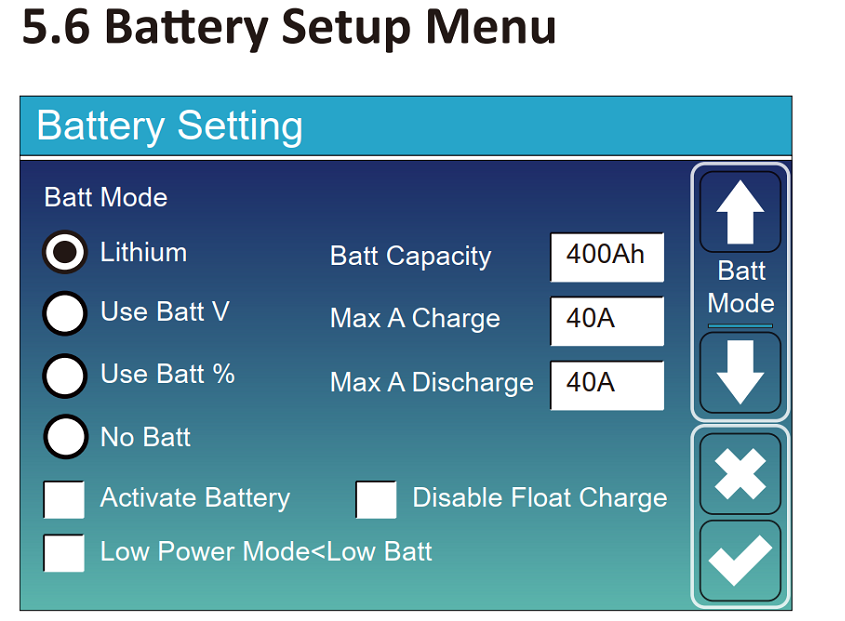
- Please select “Lithium Mode” if the battery is connected to the inverter.
- If you want to set by voltage, select “Use Batt V”.
- If you want to install by percentage, select “Use Batt %”.
- If not using battery, select “No Batt”.
- Check the box “Active Battery”. Active battery: This feature will help restore an over-discharged battery by slow charging from a solar panel system or the grid.
- Select “Batt Capacity”: adjust the capacity corresponding to the battery (after selecting 400Ah on the screen, use the up and down arrow buttons to increase or decrease the capacity) to the correct current on your storage
- For example, storage battery is 51.2v 100A then put 100Ah, if 51.2v 200A put 200Ah.
- Select “Max A Charge”: adjust the maximum charging current. Deye inverter installation guide
- Select “Max A Discharge”: adjust the maximum discharge current.
- Click the tick icon “V” on the screen to save.
Step 3.1 Choose battery settings – Deye inverter installation guide

- This is the Battery Settings page. Start = 30%:
- At 30% SOC, the system will automatically start the generator to charge the battery bank.
- A = 40A: 40A charge rate from attached generator, in Amps.
- Charge Gen: Uses the system’s generator input signal to charge the battery bank from the attached generator.
- Gen Signal: The normal Relay opens when the Gen Start signal is active.
- Gen Force: When the generator connects, it will be forced to start the generator without meeting other conditions.
- Low Noise Mode: In this mode, the inverter will operate in “low noise mode”.
- This is Charging Grid, you need to choose. ② Deye inverter installation guide
- Start = 30%: Do not use, just for customization.
A = 40A: It indicates the Current that the Grid charges the Battery. - Grid Charge: It indicates that the grid is charging the battery.
- Signal Grid: Disabled. Deye inverter installation guide
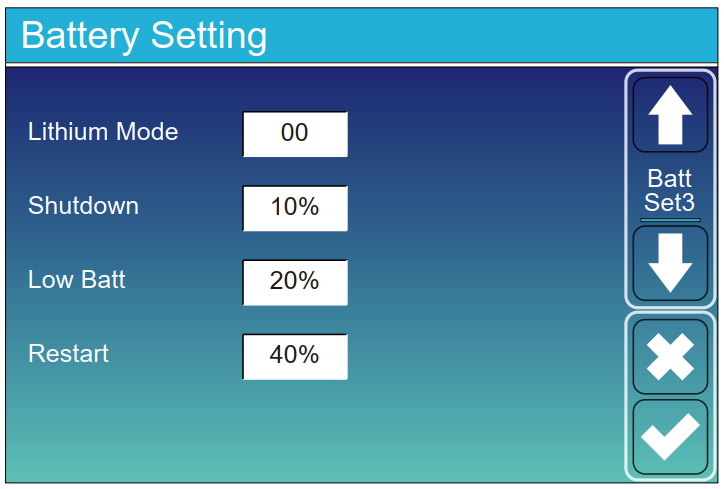
- Lithium mode: This is the BMS protocol. Please refer to the documentation (Batteries approved by the inverter manufacturer).
- Lithium Mode: select BMS communication protocol (default is 00).
- 10% Power Off: This indicates that the inverter will power off if the SOC (Battery Capacity Ratio) status is below this threshold.
- Low battery 20%: This indicates that the inverter will sound an alarm if the SOC is below this threshold.
- 40% Restart: The Battery’s voltage at 40% will be restored. Deye inverter installation guide
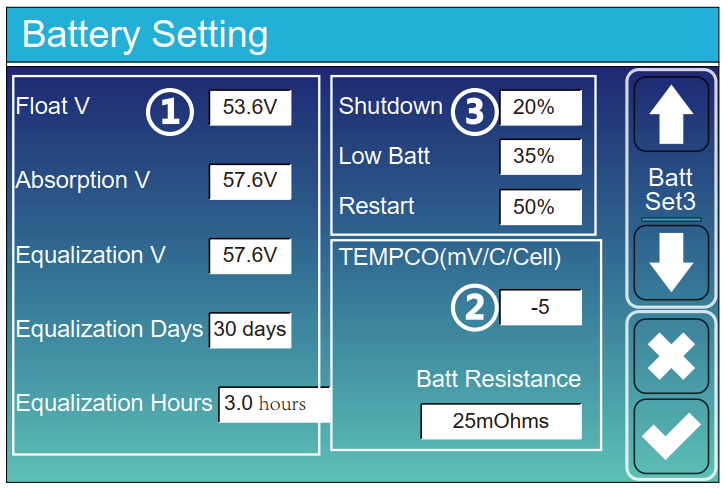
- There are 3 stages of the battery charging process. ①
- This is for professional installers, you can keep it if you don’t know. ②
- 20% Power Off: The inverter will power off if the SOC (Battery Capacity Ratio) is below this threshold.
- Low battery 35%: The inverter will sound an alarm if the SOC is below this threshold.
- Restart 50%: Battery capacity at 50% AC will be restored.
- Click the Tick “V” on the bottom right corner of the save screen.
Step 4: system installation – Deye inverter installation guide

Step 4.1: Enter System Work Mode – Deye inverter installation guide
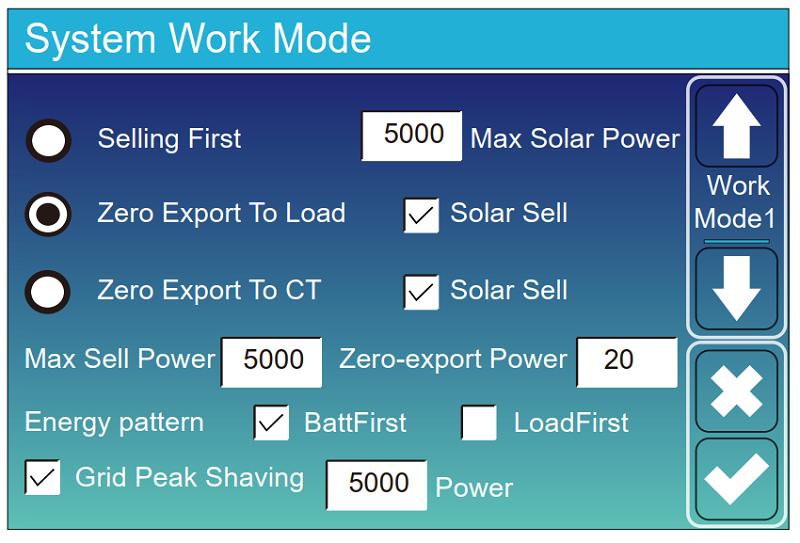
Step 4.2: Operation Mode
- Pre-sale: This mode allows the hybrid inverter to resell any excess energy produced by the solar panels to the grid. If time of use mode is activated, energy from the battery can also be sold to the grid.
- The energy from the solar panel will be used to power the load and charge the battery, then the excess energy will flow to the grid. The power supply priority for the load would be:
- 1. Solar panels. Deye inverter installation guide
- 2. Power grid. Deye inverter installation guide
- 3. Battery (until the predetermined % discharge selection is reached).
Zero Export To Load: The hybrid inverter only supplies power to the connected standby load. The hybrid inverter will not supply electricity to the home load nor will it sell electricity to the grid. The built-in CT current sensor will detect the current to the grid and will reduce the inverter’s capacity just to supply power to the local load and charge the battery.

- Select Zero Export To Load if only the load port is used to power the load.
- Select Zero Export to CT if using grid port and load to power the load.
- Tick select Solar Sell if electricity is available. Deye inverter installation guide
- Tick select BattFirst to prioritize using PV to charge the battery.
- Tick select LoadFirst to prioritize using PV for the load.
- Click the Tick on the save screen. Deye inverter installation guide
Zero Export To CT: Hybrid inverters not only provide power for connected redundant loads, but also power for connected home loads. If the power from the solar panel and battery is not enough, it will use grid energy as supplement. Hybrid inverters will not sell electricity to the grid. In this mode, it is necessary to use CT current sensor. How to install CT current sensor please refer to chapter 3.6 Connecting CT. The external CT current sensor will detect the backflow of electricity to the grid and only reduce the capacity of the inverter to power the local load, charge the battery and the home load.

-
- Solar Sell: “Selling solar energy” is for No-load or No-load mode: when this is activated, excess energy can be sold back to the grid. When it is working, the priority of using the Energy source from the solar panel will be in the following order: load consumption, battery charge and grid. Deye inverter installation guide
- Max. sell power: Allows maximum output power to flow into the grid.
- Zero-export Power: In no-export mode, this is the grid output power. It is recommended to set the range from 20-100W to ensure that the hybrid inverter does not supply power to the grid.
- Energy Pattern: Prioritizes Energy from solar panels.
- Batt First: Energy from the solar panel is used first to charge the battery, then used for the load. If the energy from the panel is not enough, the grid will supplement the battery and load simultaneously.
- Load First: Energy from the solar panel is used first to power the load, then used to charge the battery. If the energy from the panel is not enough, the grid will supplement the battery and load simultaneously.
- Max Solar Power: Allows maximum input DC power.
- Grid Peak-shaving: When active, the grid output power will be limited to the set value. If the load capacity exceeds the allowable value, it will use energy from solar panels and batteries as additional. If sales do not meet the load requirement, the grid capacity will increase to meet the load demand.
Step 4.3: set storage battery discharge time

Time of use: Used to program when to use the grid or generator to charge the battery, and when to discharge the battery to power the load. Just select “ Time of use ”, the following items (Grid, charge, tme, power etc) will take effect.
Note: when in first sale mode and click “ Time of use ”, battery energy can be sold to the grid.
Grid charge: Use the grid to charge the battery for a period of time.
Grid charge: Use the oil generator to recharge the battery for a period of time.
Time: Real time, range from 01:00-24:00.
Power: The maximum capacity of the battery that is allowed to discharge.
Batt(V or SOC %): Ratio of battery SOC or voltage when discharging the storage battery.
Example: Deye inverter installation instructions
- Between 01:00-05:00, when the battery SOC ratio is lower than 80%, it will use the grid to charge the battery until the battery SOC ratio reaches 80%.
- Between 05:00-08:00 and 08:00-10:00, when the battery SOC ratio is higher than 40%, the hybrid inverter will discharge the battery until the battery SOC reaches 40%.
- Between 10:00-15:00, when the battery SOC ratio is higher than 80%, the hybrid inverter will discharge the battery until the battery SOC reaches 80%.
- Between 15:00-18:00, when the battery SOC ratio is higher than 40%, the hybrid inverter will discharge the battery until the battery SOC reaches 40%.
- During the period from 18:00-01:00, when the battery SOC ratio is higher than 35%, the hybrid inverter will discharge the battery until the battery SOC reaches 35%.
It allows the user to choose which date to perform the setting “ Time of use: – Time of use”. Deye inverter installation guide
For example, the inverter will execute the “Time of use” page on Monday/Tuesday/Wednesday/Thursday/Friday/Saturday.
When buying an inverter at our company, you will receive a set of user manuals completely in Vietnamese and translated by us in technical specialties, not with google-translated manuals like the manual . Free use we send you reference.
Xem thêm: biến tần lai 10kw , 8kw , 5kw , 6kw , 3kw , 6kw , 5kw-sg05, 6kw-sg05, 7,6kw-sg05
The price on the website is the reference price, the price can be much better when you contact zalo directly to reduce 500k: 0907.738.988
Deye inverter is the most trusted and used brand by users today, to fully exploit its advanced functions and install recommendations from the manufacturer, please contact us to achieve efficiency and effectiveness. the best performance of the device.
Theo dõi bài viết hàng ngày của chúng tôi tại đây
Tin nhắn web đây
Hết bài 1: Hướng dẫn cài đặt biến tần Deye

